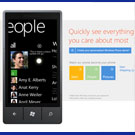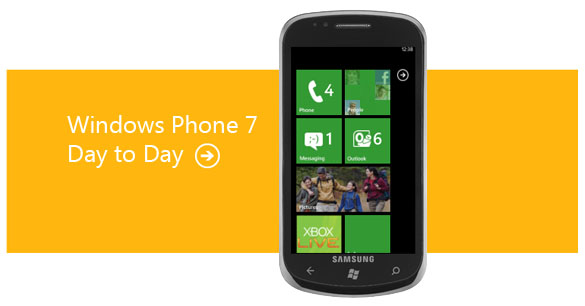Windows Phone 7 Day to Day
Microsoft tossed out the old when they relaunched their mobile strategy with Windows Phone 7. Just a week or two before the launch of the new OS, my old phone did a nosedive onto a tiled floor. Not just a drop mind you, but a slow motion flung through the air and land screen first about 10 feet away from me drop. The faint hope that the phone would survive was as shattered as the screen itself. In the time spent deliberating what to do, the phone still worked, though I had to cover the screen with cellophane to avoid dislodging glass shards. Though it continued to work, it was by no means a permanent solution. Repairing it was an option, however, it seemed like a good time to look at some of my other options.
Although I ‘get’ Android, it just never felt polished enough to me. The UI, and even most of the skins, come off as cartoony and counter-productive. Coupled with a historically bad battery life (though that’s getting better in the latest releases) and the need to fiddle to get it to where you’re mostly happy with the layout,I decided to pass. The iPhone’s a non-starter, as the longest iTunes ever lived on my computer was about 10 days. Having a phone that needed it was out of the question. WebOS, which I’ve only had limited experience with, is a very good as an operating system, but Palm’s hardware leaves much to be desired, and their new owners HP are taking a strategy I’m not sure is going to be around in the long run. Coming from the HTC HD2, there’s not much hardware that holds up to it.
Ultimately, I made the jump to Windows Phone, and more specifically the LG Optimus 7 on Telus. For the most part I’ve been more than happy making the move. The Optimus 7 is a very solid phone. While it doesn’t tout an AMOLED screen or slide out keyboard, compared to the other devices I’ve seen it’s a simple elegant device that performs smoothly. The camera is a solid shooter (though the Samsung Focus trumps it) and the battery life is fantastic. Sometimes I miss the monster screen of the HD2, but the Optimus sports a Gorilla Glass covered 3.8″ display which is plenty bright and sensitive to the touch. In short, if you’re thinking of a Windows Phone in Canada, I personally think the LG Optimus 7 is the best choice for devices without a keyboard. In many ways the Samsung Focus is a better phone, specifically the screen and camera, but it just was too light for my taste. If you’ve used a Galaxy S phone, you’ll know what I’m saying. Of course, this was before Bell started carrying the HD7, which may have been my choice if it was available at launch, but I have no regrets.
Living with Windows Phone 7
 One of the reasons I held off on writing this is that I wanted to live with the OS for a while before saying anything. It’s one thing to go through a checklist of what’s there and what’s missing. It’s another thing entirely to use it on a daily basis for an extended period of time to see how it plays out, for good or bad.
One of the reasons I held off on writing this is that I wanted to live with the OS for a while before saying anything. It’s one thing to go through a checklist of what’s there and what’s missing. It’s another thing entirely to use it on a daily basis for an extended period of time to see how it plays out, for good or bad.
After using it for over three months, I have to say I love the usability of the phone. Microsoft has done a great job in completely rethinking the UI of the mobile OS and it really shows. It’s clean and easy to navigate, and the Hub concept of the phone is what really holds it together.
In essence, what the Hubs do is organize information in ways most smartphones currently don’t. By that I mean there’s the type of information (phone number, status update, photo, etc), the person who created the information and where that information is being delivered from (Windows Live, Google, Facebook, etc). Microsoft has taken the approach of first asking “What kind of content is this?” before “Where did it come from?” The Pictures Hub is a good example of this.
If you’ve added your Facebook account to the phone, when you visit the Pictures Hub you’ll see not only the photos you’ve taken with the phone, called the Camera Roll, but the most recent photos uploaded by your friends on Facebook. Beyond viewing the pictures, you can read and add comments right away. There’s no need to launch a separate app. This type of functionality also applies to other types of data. When you visit the People Hub, there’s a “What’s New” panel that shows the latest new feed, and in the case of Facebook items can be liked, commented on and full links to external content opens in the browser.
In the same vein you can view, edit and add contacts and/or calendars from multiple services, though if you use Google Calendars, you can only modify your main calendar, which is a bit of a drawback, though the number of people this affects is probably a fairly small percentage.
Phone Services
 This is largely possible because of the integration of various cloud services from a variety of vendors, though having a Microsoft account is the most robust option, since this ties into not only Live/Hotmail email accounts, but SkyDrive for storage/backup, Zune for media and Xbox LIVE for gaming. The Zune software is accessed through the “Music and Videos” Hub. Here you’ll find what I consider one of the best mobile media interfaces I’ve seen on a phone yet. There could be some argument that the iPhone may or may not be better in some respects, but the Zune software leaves all others in the dust. Not only does it aggregate all your audio and video content, but even the history function had surprising benefits. When I wanted to show a recent Kinect hack to some friends while out at the pub, since I had viewed the YouTube video on my phone, it was right there in the history, foregoing the need to launch a browser or YouTube app and find it. This is part of that whole “What kind of content is this?” approach to organizing data.
This is largely possible because of the integration of various cloud services from a variety of vendors, though having a Microsoft account is the most robust option, since this ties into not only Live/Hotmail email accounts, but SkyDrive for storage/backup, Zune for media and Xbox LIVE for gaming. The Zune software is accessed through the “Music and Videos” Hub. Here you’ll find what I consider one of the best mobile media interfaces I’ve seen on a phone yet. There could be some argument that the iPhone may or may not be better in some respects, but the Zune software leaves all others in the dust. Not only does it aggregate all your audio and video content, but even the history function had surprising benefits. When I wanted to show a recent Kinect hack to some friends while out at the pub, since I had viewed the YouTube video on my phone, it was right there in the history, foregoing the need to launch a browser or YouTube app and find it. This is part of that whole “What kind of content is this?” approach to organizing data.
Gaming
 Gaming as a subset of apps deserves a special mention. One of the built in services is Xbox LIVE, and some of the games available for Windows Phone are Xbox LIVE enabled. To get that moniker, the game goes through a more rigourous approval process with Microsoft itself. Getting the LIVE approval also implies a pricier game. Most LIVE enabled games start at about $3, but can be as high as $7 or so depending on the title. All LIVE games for the phone have the ability to unlock Achievements. Some (though very few) actually interact with the console version. The Crackdown 2 Project Sunburst tower defense game interacts with the console Crackdown 2, by giving your bases additional abilities if you’ve reached certain milestones in the console game. This is somewhat like the Facebook game Chuck’s Ducks, which when played makes a new type of grenade available to the console player.
Gaming as a subset of apps deserves a special mention. One of the built in services is Xbox LIVE, and some of the games available for Windows Phone are Xbox LIVE enabled. To get that moniker, the game goes through a more rigourous approval process with Microsoft itself. Getting the LIVE approval also implies a pricier game. Most LIVE enabled games start at about $3, but can be as high as $7 or so depending on the title. All LIVE games for the phone have the ability to unlock Achievements. Some (though very few) actually interact with the console version. The Crackdown 2 Project Sunburst tower defense game interacts with the console Crackdown 2, by giving your bases additional abilities if you’ve reached certain milestones in the console game. This is somewhat like the Facebook game Chuck’s Ducks, which when played makes a new type of grenade available to the console player.
Other games, like chess, allow for turn based multiplayer. At the moment, there’s no real time multiplayer, though rumours suggest that Microsoft does plan on expanding on the multiplayer aspects of the phone experience. When this happens and what form it will take remains to be seen.
The only problem with LIVE games isn’t the games themselves, but what it means for non-LIVE game developers. Looking at the Marketplace from an end user perspective, MS goes out of its way to give priority to LIVE games. This is good for sales and exposure for those titles. On the flipside, I would think that non-LIVE game developers might feel they’re getting the short end of the stick. This is mainly a matter of discovering titles. For example, when going to the Games section of the Marketplace, it defaults to listing the Xbox LIVE titles. If I were a non-LIVE developer, I’d much rather it default to one of the other options (All, Paid or Free). By defaulting to only the ‘premium’ titles as it were, a lot of good games aren’t getting the recognition they deserve.
Even with that caveat, the titles are great, and Windows Phone certainly has the horsepower to play some impressively in depth mobile games, such as ilomilo, Zombies!!! and The Harvest. If the OS manages to gain some traction over the next 6 months, I think that gaming will soon be seen as one of its high points. Even though breadth of games is small compared to other mobile platforms, it’s already shown its chops, and is only bested by the selection for iOS devices.
Third party apps
 Modern smartphone OSes have made a big deal about the number of applications available to users. Apple’s iOS now has over 300,000 while Android is well over 200,000. WP7 is certainly well behind this curve, being so new. That being said, developer interest in the platform is very good, and combined with some of the better developer tools for a mobile platform should keep a steady flow as long as the phones sell. This should come as little surprise, as the phone makes use of the same development tools that can be used for making both desktop Windows programs and Xbox games.
Modern smartphone OSes have made a big deal about the number of applications available to users. Apple’s iOS now has over 300,000 while Android is well over 200,000. WP7 is certainly well behind this curve, being so new. That being said, developer interest in the platform is very good, and combined with some of the better developer tools for a mobile platform should keep a steady flow as long as the phones sell. This should come as little surprise, as the phone makes use of the same development tools that can be used for making both desktop Windows programs and Xbox games.
Since the fall launch, the Marketplace has grown to over 9500 apps, and so far shows no signs of slowing down. It should pass the 10,000 mark early next week. The early growth is on par with the Apple App Store. In short, it may not be as big as the big two, but a wide variety of apps both serious and whimsical exist, and the list continues to grow on a daily basis.
On that front, Microsoft’s recently announced partnership with Nokia can only help moving forward, not just in the arena of adoption, but in the promoting of the OS to a different developer community. There may be some developers not happy with Nokia’s new strategy, but when the details emerged about the partnership, developer interest in Windows Phone 7 definitely saw an uptick.
Drawbacks
 Even though I’ve been extremely happy overall, no OS is without drawbacks, and Windows Phone 7 is no different. In fact, there are some pretty glaring ones. Third party applications can’t multitask in the new OS, which means that music playback from services like Slacker Radio and Pandora won’t run when you exit them, or shut the screen off. Similarly, copy/paste needs to be in there for robust document editing. Getting documents on the phone is a pain in the ass right now as well. Although OneNote syncing works well in conjunction with the SkyDrive cloud service this inexplicably doesn’t extend to Excel and Word documents, meaning either loading via email or the SkyDrive web interface, which is a bit of a kludge.
Even though I’ve been extremely happy overall, no OS is without drawbacks, and Windows Phone 7 is no different. In fact, there are some pretty glaring ones. Third party applications can’t multitask in the new OS, which means that music playback from services like Slacker Radio and Pandora won’t run when you exit them, or shut the screen off. Similarly, copy/paste needs to be in there for robust document editing. Getting documents on the phone is a pain in the ass right now as well. Although OneNote syncing works well in conjunction with the SkyDrive cloud service this inexplicably doesn’t extend to Excel and Word documents, meaning either loading via email or the SkyDrive web interface, which is a bit of a kludge.
Possibly the most annoying aspect of the OS is the mish mash of services determined by what country one lives in. For example, although the Bing search works well, the voice search is handled by TellMe, which was bought by Microsoft back in 2007. This is apparently an awesome service in the US and UK, but if you’re running WP7 outside of those countries, it’s all but useless right now. I tried looking up the nearest Second Cup here in Toronto, and it points me to a place in Alaska named Second Pup. To get better results, I’ve had to change a location setting on the phone. Driving directions and traffic do work here in Toronto, but if the TellMe service doesn’t find the location, you’re going to have to enter it by address. Right now I’ve been using the free Yelp application which has more or less made up for this local deficit, but voice search is much more convenient when you’re out and about.
This problem of services also extends to the Zune Marketplace. The US market has access to all Zune services, including the monthly Zune Pass subscription, which combines unlimited access to their music library with 10 DRM free song downloads per month. Here in Canada and elsewhere, we have no Zune music at all, not even the free background artist info/art that loads into the player. Every country has a different set of services.
Some of these problems can’t be pinned on Microsoft, as it’s up to content providers to give them approval for providing services in various countries. Other shortcomings, like document syncing and copy/paste, lie squarely on Microsoft’s shoulders. On this front, it appears Microsoft is aware of the problems and plan on addressing them in updates, though the updates themselves have been a bit of a sore spot for early adopters eager for new features.
Looking forward…
 It’s not all doom and gloom though. Some of these issues will be fixed, and Microsoft has been open about them. For example, while copy/paste isn’t here yet, it should be coming with the first phone update, due out any day now. Microsoft has already expanded some of its Zune services since the launch of the phone, and when we spoke with a rep back in the summer, were told that Zune music should be hitting Canada early this year. With the recent rumour that Microsoft’s Zune HD hardware would be coming to Canada soon, it suggests that a better music service would be in tow, though it does appear that the Zune hardware may soon be subsumed by the Windows Phone platform.
It’s not all doom and gloom though. Some of these issues will be fixed, and Microsoft has been open about them. For example, while copy/paste isn’t here yet, it should be coming with the first phone update, due out any day now. Microsoft has already expanded some of its Zune services since the launch of the phone, and when we spoke with a rep back in the summer, were told that Zune music should be hitting Canada early this year. With the recent rumour that Microsoft’s Zune HD hardware would be coming to Canada soon, it suggests that a better music service would be in tow, though it does appear that the Zune hardware may soon be subsumed by the Windows Phone platform.
Overall, WP7 still has some growing to do, but it’s only been out for a few months. Even with the rough edges and some missing features, I’d take a Windows Phone 7 device over any other smartphone on the market. The day to day experience has been nothing short of fantastic, and while I don’t feel I’m doing anything ‘less’ with this phone as opposed to others I’ve tried, it’s somewhat liberating to have a phone that just works.





[…] LG Optimus 7, LG Quantum, Live, review, smartphone, Windows Phone, Windows Phone 7, WP7, Xbox LivergbFilter » Windows Phone 7 Day to Day If you enjoyed this article, please consider sharing it! Tagged with: battery life • good […]
This phone seems to have been made for adolescents with a total commitment to all things social (media + games).
I assume it also would also work well within a corporate environment that uses Microsoft Exchange Server (and other similar corporate tools) PROVIDED the phone7 features and functions have been authorized (generally not the case among the people I know).
I am a true Windows fan (no Apple computer here), yet I hate my Phone 7 and it is not because of the hardware which is very good (Samsung Focus).
It started with the discovery that this Microsoft product DOES NOT synchronizes with standalone Outlook, and it mostly got worse. For example, putting and then synchronizing documents on a Phone 7 is totally awkward. Or trying to use Mesh (another Microsoft product designed to sync favourites across devices) will not work. There is no use looking for help on the web. Useful assistance if present is very well hidden (and easier to locate through Google than Bing – but this is a different subject). Just managing my own pictures is a major pain in the “…”. Unless I choose to keep everything on the phone, sync group-management does not work properly (it only “behaves predictably” the first time). New groups that I create will generally be ignored by the phone. Also, if I take both pictures and videos of a specific event, there is no way of grouping both sets of information in a single folder (or of creating a link between the two). In a professional context, on a service call for example, this phone is absolutely the WRONG choice.
As for music I am also Canadian. In this country, the Microsoft/Zune offer is totally worthless; there is simply NO access to music. To make things worse, there is NO RELIABLE feedback by Microsoft as to when this situation will change, only rumours (but you can trace such talks all the way back to 2008).
On the subject of Microsoft communications, there is NO tool on the phone or in Zune to provide user-feedback about needed areas of improvements. It is not just the cut-and-paste, a minor problem now solved, which needed discussing. The interface “issues” are numerous, and some run very deep. The very secretive approach favoured by the Phone 7 developers makes me doubt solutions will ever be found.
And do not get me started about Sky Drive (also blocked in most corporate environments) which turned out to be “temporarily unavailable” TWICE exactly when I most depended on it… I learned not to rely on it.
Who was this software built for anyways? Certainly NOT for the general consumption of workers familiar with the Windows environment. IF you want your phone to be more than a toy, AND UNLESS you are working in an environment like Microsoft inc. where all the bells and whistles for this phone are implemented and supported at the corporate level, you will likely end up very disappointed with you Windows Phone 7.
[…] they’ve added a new touch friendly interface that follows the same Metro UI design found in Windows Phones, and users will be able to switch between the two modes seamlessly, depending on the task at […]
107248 97336As I website possessor I believe the content material material here is genuinely great , regards for your efforts. 813291